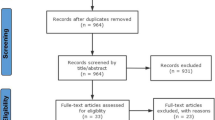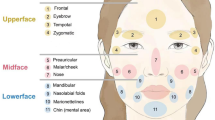Abstract
Background
Desire for improved aesthetic contour of the lower third of the face has resulted in an increase in chin augmentation. Although many fillers, including hyaluronic acid (HA), autologous fat and stromal vascular fraction gel (SVF-gel), have been used to improve facial morphology, chin augmentation requires fillers that provide greater support.
Methods
The elastic and viscous moduli of SVF-gel and Coleman fat were assessed in vitro by rheological testing, whereas their elasticity were evaluated in vivo by ultrasonic elastography. Results in vitro were compared with those of highly elastic HA (HE-HA) and highly viscous HA (HV-HA), whereas results in vivo were compared with HE-HA. Changes in chin volume, SVF-gel retention rate and absorptivity for at least 12 months were measured by 3D white light scanning. Questionnaires were administered to assess patient satisfaction.
Results
The elastic and viscous modulus of SVF-gel was, respectively, slightly lower than HE-HA and HV-HA but higher than the other two in vitro, with the elasticity of the three layers of SVF-gel lower than HE-HA but slightly higher than normal control in vivo. The average retention rate was 62.34±3.34% at 12 months. The absorptivity of 90% of the samples was <3% from 6 to 12 months, which was considered stable. Patients expressed satisfaction with their results.
Conclusion
SVF-gel has ideal rheologic characteristics in vitro, which has slightly higher elasticity than normal fat tissue of chin in vivo, and could keep well retention rate for chin augmentation in clinic.
Level of Evidence IV
This journal requires that authors assign a level of evidence to each article. For a full description of these Evidence-Based Medicine ratings, please refer to the Table of Contents or the online Instructions to Authors www.springer.com/00266.







Similar content being viewed by others
Change history
16 June 2021
A Correction to this paper has been published: https://doi.org/10.1007/s00266-021-02409-x
References
Rohrich RJ, Sanniec K, Afrooz PN (2018) Autologous fat grafting to the chin: a useful adjunct in complete aesthetic facial rejuvenation. Plast Reconstr Surg. 142(4):921–925
Chang CS, Kang GC (2016) Achieving ideal lower face aesthetic contours: combination of tridimensional fat grafting to the chin with masseter botulinum toxin injection. Aesthet Surg J. 36(10):1093–1100
Lee TS, Kim HY, Kim TH, Lee JH, Park S (2014) Contouring of the lower face by a novel method of narrowing and lengthening genioplasty. Plast Reconstr Surg. 133:274e–282e
Li J, Hsu Y, Khadka A, Hu J, Wang D, Wang Q (2011) Contouring of a square jaw on a short face by narrowing and sliding genioplasty combined with mandibular outer cortex ostectomy in orientals. Plast Reconstr Surg. 127:2083–2092
Baek RM, Han SB, Baek SM (2001) Surgical correction of the face with the square jaw and weak chin: angle-to-chin bone transfer. Plast Reconstr Surg. 108:225–231
Newberry CI, Mobley SR (2019) Chin augmentation using silastic implants. Facial Plast Surg. 35(2):149–157. https://doi.org/10.1055/s-0039-1683867
Plastic Surgery Statistics Report. https://www.plasticsurgery.org/ news/plastic-surgery-statistics. Accessed January 20, 2019.
Coleman SR (2002) Hand rejuvenation with structural fat grafting. Plast Reconstr Surg. 110(7):1731–1747
Coleman SR (2006) Structural fat grafting: more than a permanent filler. Plast Reconstr Surg. 118(3 Suppl):108S-120S
Donofrio LM (2008) Techniques in facial fat grafting. Aesthet Surg J. 28(6):681–687
Fagien S, Bertucci V, von Grote E, Mashburn JH (2019) Rheologic and physicochemical properties used to differentiate injectable hyaluronic acid filler products. Plast Reconstr Surg. 143(4):707e–720e
Stocks D, Sundaram H, Michaels J, Durrani MJ, Wortzman MS, Nelson DB (2011) Rheological evaluation of the physical properties of hyaluronic acid dermal fillers. J Drugs Dermatol. 10(9):974–980
Atashroo D, Raphel J, Chung MT et al (2014) Studies in fat grafting: part ii effects of injection mechanics on material properties of fat. Plast Reconstr Surg 134(1):39–46
Yao Y, Dong Z, Liao Y et al (2017) Adipose extracellular matrix/stromal vascular fraction gel: a novel adipose tissue-derived injectable for stem cell therapy. Plast Reconstr Surg. 139(4):867–879
Cai J, Wang J, Hu W, Lu F (2020) Mechanical micronization of lipoaspirates for the treatment of horizontal neck lines. Plast Reconstr Surg. 145(2):345–353
Sahan A, Karaosmanoglu N, Ozdemir CP (2020) Chin augmentation with the use of cannula from a single, midline entry point: evaluation of 50 patients. J Cosmet Dermatol. 19(6):1301–1306
Kablik J, Monheit GD, Yu L, Chang G, Gershkovich J (2009) Comparative physical properties of hyaluronic acid dermal fillers. Dermatol Surg. 35(Suppl 1):302–312
Lorenc ZP, Öhrlund Å, Edsman K (2017) Factors affecting the rheological measurement of hyaluronic acid gel fillers. J Drugs Dermatol. 16(9):876–882
Edsman KL, Wiebensjö ÅM, Risberg AM, Öhrlund JÅ (2015) Is There a method that can measure cohesivity? cohesion by sensory evaluation compared with other test methods. Dermatol Surg. 41(Suppl 1):S365–S372
Moradi A, Shirazi A, David R (2019) Nonsurgical chin and jawline augmentation using calcium hydroxylapatite and hyaluronic acid fillers. Facial Plast Surg. 35(2):140–148
Delay E, Garson S, Tousson G, Sinna R (2009) Fat injection to the breast: technique, results, and indications based on 880 procedures over 10 years. Aesthet Surg J. 29(5):360–376
Sinna R, Delay E, Garson S, Delaporte T, Toussoun G (2010) Breast fat grafting (lipomodelling) after extended latissimus dorsi flap breast reconstruction: a preliminary report of 200 consecutive cases. J Plast Reconstr Aesthet Surg. 63(11):1769–1777
Zhang Y, Cai J, Zhou T, Yao Y, Dong Z, Lu F (2018) Improved long-term volume retention of stromal vascular fraction gel grafting with enhanced angiogenesis and adipogenesis. Plast Reconstr Surg. 141(5):676e–686e
Zhu H, Ge J, Chen X, Lu F, Cai J (2019) Mechanical micronization of lipoaspirates for regenerative therapy. J Vis Exp. https://doi.org/10.3791/58765
Wang J, Liao Y, Xia J et al (2019) Mechanical micronization of lipoaspirates for the treatment of hypertrophic scars. Stem Cell Res Ther. 10(1):42
Feng J, Hu W, Fanai ML et al (2019) Mechanical process prior to cryopreservation of lipoaspirates maintains extracellular matrix integrity and cell viability: evaluation of the retention and regenerative potential of cryopreserved fat-derived product after fat grafting. Stem Cell Res Ther. 10(1):283
Spiekman M, van Dongen JA, Willemsen JC, Hoppe DL, van der Lei B, Harmsen MC (2017) The power of fat and its adipose-derived stromal cells: emerging concepts for fibrotic scar treatment. J Tissue Eng Regen Med. 11(11):3220–3235
Chun SY, Lim JO, Lee EH et al (2019) Preparation and characterization of human adipose tissue-derived extracellular matrix, growth factors, and stem cells: a concise review. Tissue Eng Regen Med. 16(4):385–393
Chiquet M, Birk DE, Bönnemann CG, Koch M (2014) Collagen XII: Protecting bone and muscle integrity by organizing collagen fibrils. Int J Biochem Cell Biol. 53:51–54
Latinovic O, Hough LA, Daniel O-Y (2010) Structural and micromechanical characterization of type I collagen gels. J Biomech. 43(3):500–505
Kisling A, Lust RM, Katwa LC (2019) What is the role of peptide fragments of collagen I and IV in health and disease? Life Sci. 228:30–34
Qiao J, Jia QN, Jin HZ et al (2019) Long-term follow-up of longevity and diffusion pattern of hyaluronic acid in nasolabial fold correction through high-frequency ultrasound. Plast Reconstr Surg. 144(2):189e–196e
Wang Q, Zhao Y, Li H, Li P, Wang J (2018) Vascular complications after chin augmentation using hyaluronic acid. Aesthetic Plast Surg. 42(2):553–559
Yuan JT, Chang TW, Yu SS, Arron ST (2017) Mental artery occlusion from poly-l-lactic acid injection at the lateral Chin. Dermatol Surg. 43(11):1402–1405
Vanaman Wilson MJ, Jones IT, Butterwick K, Fabi SG (2018) Role of nonsurgical chin augmentation in full face rejuvenation: a review and our experience. Dermatol Surg. 44(7):985–993
Tansatit T, Phumyoo T, Sawatwong W, McCabe H, Jitaree B (2020) Implication of location of the ascending mental artery at the chin injection point. Plast Reconstr Surg. 145(1):51e–57e
Acknowledgements
Thanks for the experimental site and equipment provided by The Plastic and Aesthetic Center, The First Affiliated Hospital of Harbin Medical University.
Funding
The author(s) disclosed receipt of the following financial support for the research, authorship, and/or publication of this article: This work was supported by Natural Science Foundation of Heilongjiang Province, China (QC2018102), and President Foundation of The First Affiliated Hospital of Harbin Medical University (2019B24).
Applied Technology Research and Development Project of Heilongjiang Province (GA20C019).
Author information
Authors and Affiliations
Corresponding authors
Ethics declarations
Conflict of interest
The authors declare that they have no conflict of interest.
Ethical approval
The study protocol was approved by the institutional review board.
Informed consent
All patients provided informed consent.
Additional information
Publisher's Note
Springer Nature remains neutral with regard to jurisdictional claims in published maps and institutional affiliations.
The original online version of this article was revised: Figure 6 was updated to replace duplicated image with the correct image.
Rights and permissions
About this article
Cite this article
Wang, Q., Chen, X., Wang, X. et al. A Reliable Method for Chin Augmentation by Mechanical Micronization of Lipoaspirates. Aesth Plast Surg 45, 1507–1517 (2021). https://doi.org/10.1007/s00266-021-02237-z
Received:
Accepted:
Published:
Issue Date:
DOI: https://doi.org/10.1007/s00266-021-02237-z




